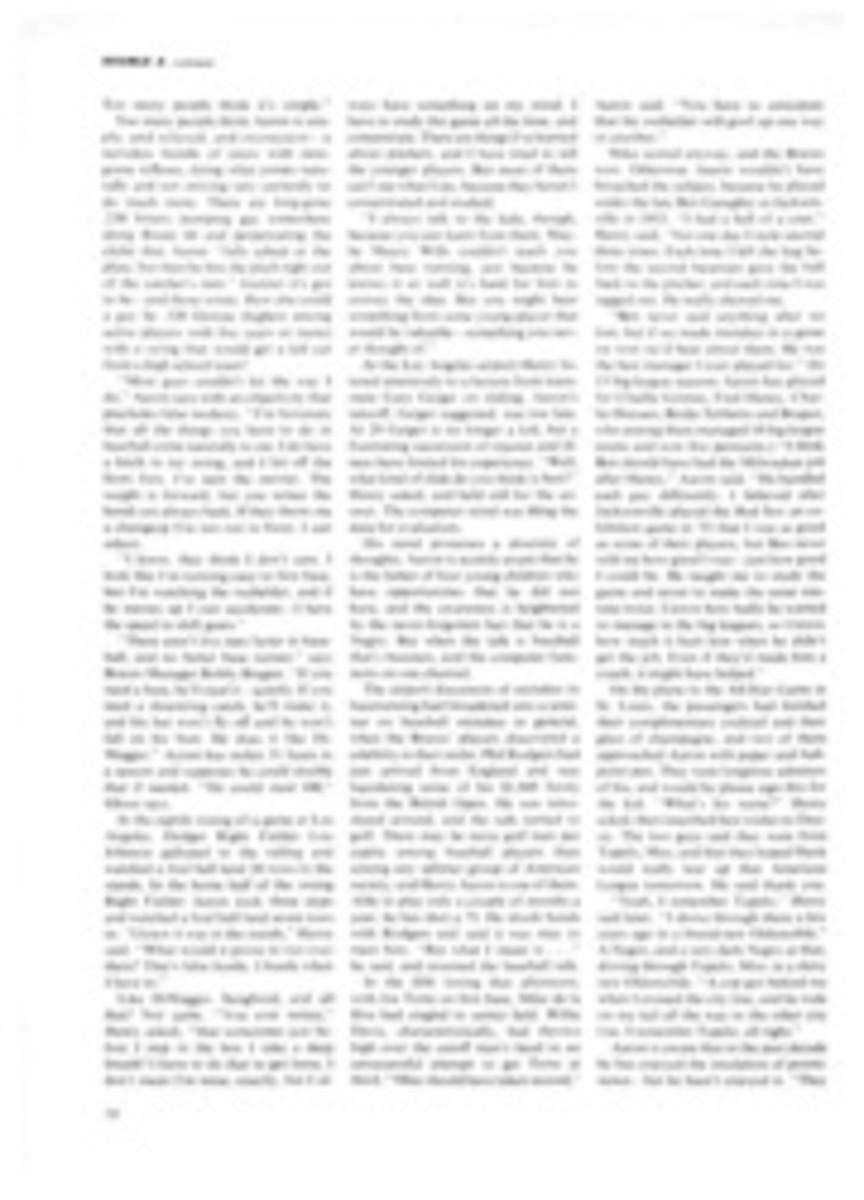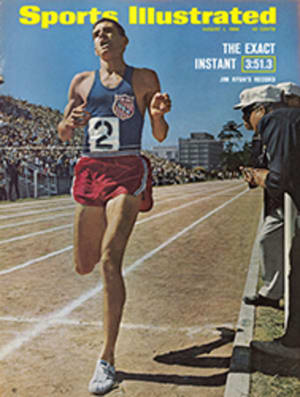
A SPECIAL BRAND OF FAME
Young Jim Ryun's hectic life as the world record holder in track's most glamorous event began even while he was spinning off the 3:51.3 mile (see cover) he ran in Berkeley, Calif. a week ago last Sunday. During the race a souvenir hunter stole his warmup shoes. Some 45 minutes later, on his short journey from the Edwards Stadium track to the University of California dormitory in which he was billeted, he began to sample his first really heady dose of public adulation. Ryun covered the three blocks barefoot and at a full gallop, pursued closely by a mob of children and adults, and then bounded up the seven flights of stairs to his room when he found the elevator in use.
"Those people didn't want autographs," Ryun said later, shuddering slightly. "They were after pieces of clothing."
This was only the beginning of the week that was for the 19-year-old boy who had just finished his freshman year at the University of Kansas, who had just cut 2.3 seconds off the world mile record, who had become the first American in 29 years to hold that title and who had predictably emerged as one of the most exciting figures in all of sport. Before the week had ended Jim Ryun had turned down a $50-a-day offer, cautiously felt his way through some 30 interviews for press, radio and television, had shaken countless hands and had autographed two $100 bills for a pair of entranced fans. He even managed to fit in a leisurely 1:46.2 victory in the 880-yard run (his world record is 1:44.9) at the Los Angeles Times International Games in the Coliseum, the substitute for the dual meet that never was between the U.S. and the U.S.S.R., a meet highlighted by two world records. Most important of all, Ryun was beginning to bring into focus the things that were happening to him now and the things that would happen in the months to come.
On the Sunday evening following his destruction of Michel Jazy's world record—not to mention his establishment of an unofficial record in the barefoot, seven-flight sprint—Ryun was handed a thick sheaf of telephone messages. Truly aghast, his first thought was to toss them all in the wastebasket. Then he reconsidered and began to work his way through the list, which included a request for telephone interviews with NBC and CBS radio in New York. Later, at the conclusion of a banquet in downtown Oakland, Ryun and two friends set off hoping to see San Francisco from the Top of the Mark and enjoy a soft drink while they gazed out at the city. Alas, Ryun's fame had not preceded him that far. "I have never heard of Jim Ryun," announced the manager as he barred the way, firmly citing a California law that forbids a cocktail lounge even to offer a minor a chair to sit in. When he returned home that night he was too tired to write an entry in his track notebook, in which he records time and distance of his training runs.
On Monday morning Ryun placed telephone calls to three papers back home, the Lawrence Daily Journal-World, The Wichita Beacon and The Kansas City Star, to discuss his record mile. Then he drove up to Sacramento with his summertime employer at The Topeka Capital-Journal, Photo Director Rich Clarkson, to assist on an assignment Clarkson was undertaking for the President's Council on Physical Fitness. They were greeted there by one Casey Conrad of the California Department of Education.
"I'm pleased to see that Jim wears glasses," Conrad remarked. "It proves he's human."
On Tuesday and Wednesday Ryun worked with Clarkson at various public schools in Sacramento, shooting pictures of the city's physical-fitness program for children. He chatted informally with the groups they encountered, was interviewed by a Sacramento paper and two local TV stations. In front of a TV camera Jim Ryun is no Johnny Carson. In one session he said, "We'll have to wait and see" no less than four times, which is amusing only in a negative sort of way. "Let's wait and see, let's wait and see," the live Jim Ryun laughingly parroted later as he watched his videotape counterpart on the television set in his motel room.
While in Sacramento, Ryun was called by a Washington group connected with the President's Council on Physical Fitness. Apparently, the mile record is worth $50 a day just for openers. Would he like to earn that sum, plus expenses, for a six-week tour of the country, extolling the virtues of fitness to high school students? The money was attractive but so was his status as an amateur athlete. "I guess not," he finally replied.
On Thursday Ryun sandwiched a flight down to Los Angeles between confrontations with TV cameras at both the Sacramento and Los Angeles airports, then settled into a dormitory at the University of Southern California with the rest of the athletes competing in the International Games. His presence triggered an endless series of incoming telephone calls to the pay station on his floor. Hefty Neal Steinhauer, the Oregon shotputter, put in the better part of a morning blocking out one persistent caller by saying that Ryun was taking a shower. "But he's been in the shower for 45 minutes," the caller wailed about the third time around. "Jim Ryun is a very clean boy," Steinhauer explained.
On Thursday night Ryun was at Disneyland when a prosperous track fan came up to shake his hand, then pulled a roll of bills from his pocket, handed Jim a crisply pressed $100 bill and asked him to autograph it.
"I don't even remember whose face was on the bill," said Ryun. "All I could see was that big one, zero, zero."
Van Nelson, the long-distance runner from tiny St. Cloud State College in Minnesota, was present for this curious exchange, and was so impressed that he turned up two days later with a $100 bill of his own for Ryun's signature.
By Friday night Ryun had adjusted to his new role as track's newest hero and was in a mood to reflect on what it all meant. After dinner at the Castaway restaurant in the hills high above suburban Burbank he lounged on the terrace, sipped at a Coca-Cola and looked at the lights in the valley below. At 19, Jim Ryun is nobody's fool. In the last two years he has matured rapidly. He now jokes where he once could muster only a shy smile. He is articulate where once he mumbled monosyllabically. He is now relaxed and open where once he was tense and withdrawn. He has suddenly gained the calm assurance of someone years older who has been through all this before.
"I guess the hardest thing to get used to is all the attention from the press and from television, the constant questioning," he said. "Some of the interviews are really good. When the person I'm talking to is genuinely interested in what I'm talking about it's pretty easy to get enthusiastic. But I'm never going to get used to the guy you've met maybe once before in your life who comes up, throws his arm around your shoulder, blows smoke in your face and says 'Hiya, pal.' "
Nor can Ryun get used to answering the two questions most commonly asked: How fast do you think you can run? How do you stand the pain?
"Too much is made of the pain stuff," he says. "Running doesn't hurt that much. I've often tried to explain to people that there is more satisfaction than pain in a hard workout, but I guess too many of them just can't understand that work can be satisfying. Besides, if running a race hurt as much as people seem to think it does, I wouldn't get out on the track in the first place."
Ryun's stock response to the question of how fast do you think you can run is always the cautious, "Let's wait and see." but he does set definite goals. He firmly believes in goals and finds them a vital inspiration for his training.
"If you set up a goal of something like 3:50, say, for the mile run, it gives you a target to aim at," he says. "You think what a 3:50 mile really is—four 57.5 quarters—and you realize how much work you have to do to be able to run a mile at that pace. It's important, of course, not to get too discouraged if you don't make it."
Ryun's target this year had been to return the one-mile record, held so long ago by a fellow Kansan, Glenn Cunningham, to the U.S. But following the disappointing lime for his mile win at the AAU Championships in New York (SI, July 4), the record seemed to remain at least a year's reach away. Still, he was not particularly disappointed. All in all, it had been a good year.
"I had brought my best mile performance down to 3:53.7, and it had been a very good competitive year," he explained. Now that the record is his, however, he does feel a strong sense of relief and satisfaction. It has also altered somewhat his goals for next year.
"I haven't ever done anything good on the international level," he says. "I think now I'll begin to take the emphasis off trying to beat the clock and start thinking about beating the best runners."
Anyone who saw his explosive race at Berkeley would not consider this a particularly difficult assignment, even against Michel Jazy of France, the deposed record holder, or East Germany's Jürgen May, who came so close to Jazy's world record last January, or Kipchoge Keino of Kenya, who thrives on a diet of high-altitude training. Despite the pressure of planning a direct assault on the world record, Jim Ryun was as relaxed the afternoon of his record run as a man snoozing in a hammock. In fact, lying down outside the stadium not long before the race, the runner who was about to start carrying the often excruciating burden of being the man alone at the top, who was about to discover how often the penalties of fame have a way of interfering with its pleasure, who was perhaps about to change his whole pattern of life, almost fell asleep.
Ryun was awake but still utterly relaxed as the race began, and he settled into a good position behind the series of leaders who had resolved to set a fast pace. For a few moments Ryun's legs felt a little heavy, as if they were losing some of their snap and spring, but when he took the lead with 700 yards to go he felt a sudden surge of lightness and strength. When he raced past the three-quarter mark and heard the time announced as 2:55 his first thought was: "Hey, maybe I can get under 3:50."
This sort of reaction may be the significant difference between Jim Ryun and any other miler in the world today. He possesses the fearlessness of extreme youth. An older, more experienced runner would almost certainly have thought: "Whoa, 2:55. Maybe I've been running too fast."
Suitable modesty and a large amount of good sense will always prevent him from saying so, but the next time he is asked how fast he thinks he can eventually run the mile Jim Ryun could skip the "Let's wait and see" routine and in all truth predict: "Oh, about 3:45. And not too long from now, either."
PHOTO
TRUMPETS SOUND as Ryun marches into the Los Angeles Coliseum for last Sunday's meet.
PHOTO
RICH CLARKSON
A PAGE FROM RYUN'S TRAINING BOOK SHOWS WHAT IT TAKES TO RUN A 3:51.3 MILE
PHOTO
MOMENTARILY MORTAL, RYUN SITS IN COLISEUM AND GRINS BENEATH A SILLY HAT

